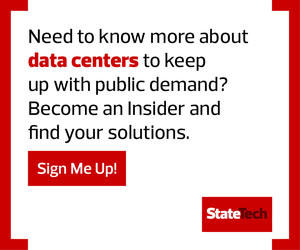Automation Helps Drive Efficiency for Agencies
State government IT workers were already overworked and dealing with tightened budgets before the pandemic hit. Today, state and local government agencies are facing severe budget constraints because of the pandemic, with shortfalls expected to reach $555 billion between 2020 and 2022.
As such, IT leaders should consider using automation technology both to help their teams become more efficient and to allow them to focus on high-value projects that directly affect the success of their missions.
Immediate attention should be paid to automating routine tasks that are essential but time-consuming and that may be difficult for remote teams to manage. Examples include provisioning and configuring compute resources such as virtual machines, infrastructure workflows, security responses and network configurations. Even the process of application development can be automated, supporting agencies’ efforts to implement modern development methodologies such as DevOps.
Automation is about working smarter, not harder. That ethos will prove valuable into 2021 and beyond. An investment in automation today can certainly help agencies manage efficiency challenges in the moment. It will also lay the foundation for a more agile and flexible environment, allowing IT managers to focus on developing innovative and value-added solutions that will help them deliver better and more effective services to their colleagues and the public at large.
MORE FROM STATETECH: Discover how state and local governments can tap chatbots to slash staff workloads.
Distributing Compute Across the Hybrid Cloud
In addition to automation, agencies should consider using cloud and edge deployments for effective data center management in a virtual work environment. Data centers can no longer be maintained or served in the traditional manner, but public cloud services can help teams manage and schedule applications remotely.
Through the cloud, agencies can reduce the time needed for patching, provisioning and configuration down to minutes. The time savings can significantly contribute to overall team efficiency — a metric that many agencies are likely to be measuring while their teams are stretched thin. Agencies can also automate software deployments to edge locations, such as health clinics, testing centers and schools.
This requires a commitment to a hybrid cloud model, where agencies integrate applications and data across multiple hosting environments for workload portability, orchestration and management. Hybrid cloud deployments tie together disparate edge systems, providing a consistent foundation that makes it easier to manage and leverage devices at the network’s edge. With this foundation, IT teams can more easily manage tens of thousands of devices in remote locations, all from the comfort of their own remote locations.
In 2019, Michigan’s Department of Technology, Management and Budget (DTMB) began efforts to support the digital transformation of both citizen-facing services and internal operational processes. A key part of these efforts was consolidating and standardizing the state’s IT infrastructure to support its various agencies with a shared platform.
According to DTMB CTO Jack Harris, “Containerizing our applications helped us establish a vendor-agnostic view of our infrastructure and gives us the freedom to move into cloud environments in the future, where appropriate.”
In addition to creating a flexible future for cloud adoption, DTMB reduced its time to market for new, digital data services and improved infrastructure security by using consistent container images to support its applications on the hybrid cloud.
LEARN MORE: What does software-defined everything mean for state governments?
Shifting to Support New Data and Security Requirements
Since early 2020, organizations have been reconfiguring networking architectures and policies in their data centers to support this year’s challenges. Many agencies, like those focused on health and human services and education, are charged with delivering technologies that accommodate governments and citizens while also attempting to innovate other existing business-related missions.
To make matters worse, the threat of cybercrime against healthcare providers in 2020 is also increasing. Providing better security while continuing to innovate depends on the ability to make consistent configuration changes across environments and roll back those changes as necessary in the event of failures. Automating security, from initial protection through remediation, can help reduce the risk of misconfigurations and help improve rapid responses to potential threats.
Agencies should also consider developing configuration “playbooks” that can be shared among team members so everyone remains on the same page and equipped to adopt successful security automation strategies.
Agencies are still grappling with the realities brought on by distributed workforces, reduced budgets and increased risk as we enter 2021. Adopting an automation strategy now can help them maintain continuity, improve efficiencies and strengthen their security postures during these disruptive times.










